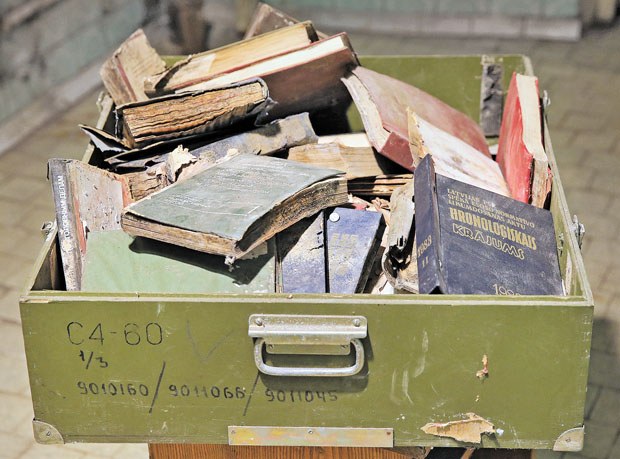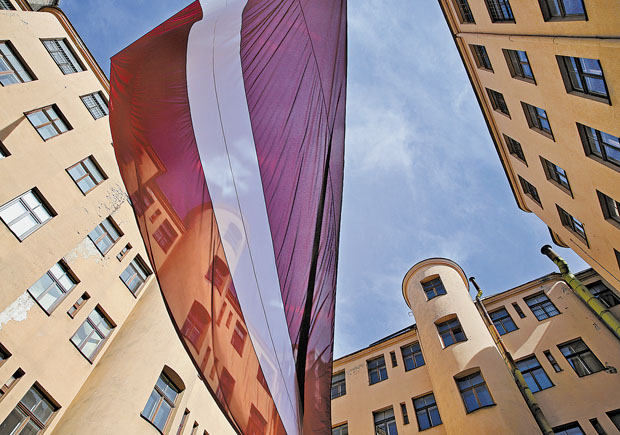KGB or the house “that has something to tell” opens is Riga

How much time should pass for the countries that want to get rid of the prefix “post-” to realize and reflect on their Soviet past? Probably, this period of time is different for every country, depending on its readiness. Today Latvia is one of the few countries which can hardly be called post-Soviet, because it is a full-fledged member of the EU, and for the time being the rate of its economic development is considered to be the highest in Europe.
The country has never stopped to work on its history and continues to do so. A considerable part of the research is done by historians and scholars of the Museum of the Occupation of Latvia. This year under the umbrella of the museum and project “Riga – European Capital of Culture 2014” the building of KGB of Latvian SSR has been opened.
It is symptomatic that the former KGB house in Latvia, or as it is called the Corner House (built in 1912 based on the design of architect Aleksandrs Vanags), is located at the corner of the streets Brivibas and Stabu. Brivibas is translated from Latvian as freedom. Since autumn 1940 Latvian people were deprived of this freedom. However, at that time the street was bearing Lenin’s name.
There is a popular Latvian “anecdote” that Siberia can be seen even from the windows of its basement (as you can understand, there are no windows in the basement). So, those who got there could not go back.
Before the occupation of the country by Soviet Russia, it was a usual house, whose residents were living a usual life: had dinner, had fun, raised children, and washed socks. Later they could not either have fun or live. The house was given for the KGB. Its basements became prison wards, and the upper floors – rooms for interrogations, fear, hatred, and at the same time pride and courage. There the informants were recruited and the “unfaithful” (patriots of Latvia) were killed. After the collapse of the USSR the KGB employees escaped, taking tons of documents with them. Therefore the historians continue to work with the premises and archives that were left.

RESEARCHERS CONTINUE TO FIND IN THE BUILDING EVIDENCE OF CRUELTY OF THE KGB
The six-floor building with a total area of 8,000 square meters is today practically empty. Everything remains here the way Chekists left it: old wallpapers, desks, suitcases, mugs, portraits, maps, lamps, red flooring. In the former wards one can listen to recollections of dissidents and relatives of those who were killed, listen to lectures of historians and leading scholars who work with this topic, and see artworks dedicated to the topic of repressions and imprisonment (incidentally, an international exhibit with Mykola Kadan’s works on display was recently opened here. His works from the cycle “Procedure Room” of 2009-10 are now on display in the PinchukArtCentre Gallery within the framework of the project “Fear and Hope”).
“With this exposition we are writing a new page into the history of this house which has much to tell,” a historian of the Museum of Occupation of Latvia Richard Petersons at the launch of the project.
There is a big question what should be done to this house. On a central noisy street with expensive shops and cafes, near to residential houses, the corner house looks like a ghost, a house with a past; but what future awaits it? Hardly anyone will be eager to revive the life which existed here before 1940. And a building, which extends almost for a residential block cannot stay empty for long. Therefore the question on its future is open, it is planned to solve it in 2015. Will the museum with a scientific center, educational programs, and art ground remain there, or a decision will be made to give an absolutely new sense to the building?

THE WINDOWS OF THE WARDS LOOKED OUT TO THE YARD. CURRENTLY A HUGE FLAG OF LATVIA IS STANDING IN THE YARD
“I remember my conversation with a Hungarian writer, a Nobel Prize winner Imre Kertesz, who asserted that it would take 20 years after the Holocaust for a novel about Holocaust to appear. One hundred years have passed since the beginning of the World War I and 20 years after the state independence was restored, so that owing to our historical experience we could assess the stories that have emerged in this period, continue the everlasting work of discovering history, give an impetus to discussion on what historical point Latvia and Riga are staying now,” Gints Grube, a curator of thematic line “Street of Freedom” of the program of “Riga-2014” noted in one of his interviews. In his words, opening of the KGB building is a huge event in Latvian history. But in fact not only Latvian. For this house symbolizes a period of time of the entire (post) Soviet space, the Baltic countries, Ukraine, Belarus, the Caucasus countries, and Russia.
There are no such analogues in Ukraine. There is Lontskoho Street Museum in Lviv, there are corresponding stands in the history museums of cities, local lore museums. But all of them do not create the large-scale understanding of what was taking place in those years, how many people were repressed, how many fates were crippled, there is no process of cognizing the past by ways of pictorial art, music, literature, cinema, gathered in one place.
It took Latvians two decades to open the KGB House. You should agree that their experience is worth of being borrowed.
The project “Corner House. File no.1914/2014” will be opened for visitors in Latvian capital, which this year is a culture capital of Europe, before October 19.






